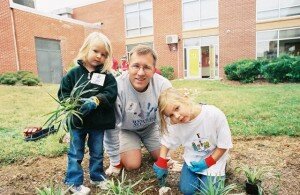 Yesterday’s post introduced the idea of neighboring. It’s a place-based approach to community problem solving that focuses on individuals’ talents as a resource to improve their neighborhoods.
Yesterday’s post introduced the idea of neighboring. It’s a place-based approach to community problem solving that focuses on individuals’ talents as a resource to improve their neighborhoods.
We’ve found seven ways that individuals, organizations, and businesses can use when working with communities to engage and empower local volunteers and to build effective partnerships with their community. Whether you’re planning a short-term volunteer project or a long-term community initiative, these tips can help bring about real change!
1. Try to understand the language and nature of volunteering
- Understand the history and culture of the community.
- Include youth, immigrant communities, seniors, faith communities, and refugees.
2. Overcome barriers to volunteering.
- Understand the community obstacles. What has traditionally kept people from volunteering?
- Understand the organizational barriers. Have organizations tried to work in the community previously? What made their actions successful?
3. Empower the community.
- Create space for residents to own their issues and develop solutions.
- Support residents to witness the benefits of their involvement.
- Engage residents in the decision-making process.
- Mobilize residents around issues that impact them directly.
- Host community meetings and provide examples of success.
4. Cultivate community members’ skills and talents.
- Acknowledge and build on existing community assets.
- Help members identify their own skills and talents.
- Allow residents to have a real role in the partnership.
- Encourage residents to plan and lead projects.
- Show the relationship between residents’ skills and project outcomes.
5. Strengthen existing community leadership.
- Cultivate leadership and the internal capacity of community members to lead and engage in community activities.
- Help develop leadership and recognize different leadership styles.
- Identify volunteer leadership development training.
- Encourage leaders to have a leadership role in the partnership.
6. Acknowledge that volunteering is an exchange.
- Offer volunteers something in exchange for the time, talents, and efforts they contribute to bettering their communities. A simple, honest, thank you note is enough to recognize each person’s contribution, but you can always do more.
- Help people see the benefits of the work that has been done, and the work that they can do.
- Understand that it’s okay to receive something in exchange for volunteering.
- Develop mechanisms by which residents receive tangible outcomes such as tutoring, child care subsidies, and job opportunities.
7. Ensure community readiness.
Participate in building the internal capacity of communities to partner with outside organizations and engage residents in community activities.
- Be patient; community building and resident involvement takes time.
- Remember that relationship building is a process.
- Be flexible; survival issues demand time and attention.
- Help communities resolve conflict that may be preventing involvement.
- Set your community up for success but accept if it is not ready.
Have you used neighboring practices in your community? Let u know what worked for you in the comments!
Related articles
- Seven Essential Strategies for Engaging Local Residents in Community Projects
- 4 Tips for Incorporating Neighboring into Existing Programs

 Neighbors help neighbors.
Neighbors help neighbors. Neighboring is a place-based way of volunteering that builds on the talents and resources of local residents to strengthen families and elevate struggling communities into flourishing, vibrant places to live. It is about the connections among residents that support positive individual and community behavior based on mutual respect, responsibility, and ownership.
Neighboring is a place-based way of volunteering that builds on the talents and resources of local residents to strengthen families and elevate struggling communities into flourishing, vibrant places to live. It is about the connections among residents that support positive individual and community behavior based on mutual respect, responsibility, and ownership. Neighboring is an asset- and empowerment-based approach that engages underserved and underresourced community members to find innovative, sustainable solutions to address local challenges. Asset-based refers to the acknowledgment that all members of a community can offer something to improve the community: talents, skills, knowledge, or resources. The resident-led approach primarily focuses on a specific geographic area (i.e., ZIP code, neighborhood, or street) in which the majority of the volunteers, activities, and organization come from within a community.
Neighboring is an asset- and empowerment-based approach that engages underserved and underresourced community members to find innovative, sustainable solutions to address local challenges. Asset-based refers to the acknowledgment that all members of a community can offer something to improve the community: talents, skills, knowledge, or resources. The resident-led approach primarily focuses on a specific geographic area (i.e., ZIP code, neighborhood, or street) in which the majority of the volunteers, activities, and organization come from within a community.

 s. This idea incorporates the concept of Neighboring, or the idea that communities – especially those in underserved and under resourced areas – should be engaged in their own change, not have solutions scripted for them by outsiders. As we engage our children and students this holiday season, it’s important to think deeply about this model. When you are out purchasing food, clothing, toys, or other goods to donate to holiday collections, or participating in service with organizations to create change, what can you do to extend the connection with the populations on the receiving end?
s. This idea incorporates the concept of Neighboring, or the idea that communities – especially those in underserved and under resourced areas – should be engaged in their own change, not have solutions scripted for them by outsiders. As we engage our children and students this holiday season, it’s important to think deeply about this model. When you are out purchasing food, clothing, toys, or other goods to donate to holiday collections, or participating in service with organizations to create change, what can you do to extend the connection with the populations on the receiving end?
 for overcoming some of the challenges you might face when you’re starting a neighboring program. Today, we wanted to share some more.
for overcoming some of the challenges you might face when you’re starting a neighboring program. Today, we wanted to share some more. Neighboring by its nature tries to effect systemic change to challenges that have, over generations, become engrained in every aspect of your target community. This is inherently difficult to do. All agencies that engage in Neighboring have significant hurdles to overcome, even after several years of successful programming.
Neighboring by its nature tries to effect systemic change to challenges that have, over generations, become engrained in every aspect of your target community. This is inherently difficult to do. All agencies that engage in Neighboring have significant hurdles to overcome, even after several years of successful programming.
